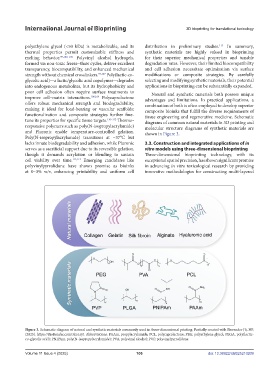Page 114 - v11i4
P. 114
International Journal of Bioprinting 3D bioprinting for translational toxicology
polyethylene glycol (<50 kDa) is metabolizable, and its distribution in preliminary studies. In summary,
115
thermal properties permit customizable stiffness and synthetic materials are highly valued in bioprinting
melting behavior. 99,104–106 Polyvinyl alcohol hydrogels, for their superior mechanical properties and tunable
formed via non-toxic freeze–thaw cycles, deliver excellent degradation rates. However, their limited biocompatibility
transparency, biocompatibility, and enhanced mechanical and cell adhesion necessitate optimization via surface
strength without chemical crosslinkers. 99,107 Poly(lactic-co- modifications or composite strategies. By carefully
glycolic acid)—a lactic/glycolic acid copolymer—degrades selecting and modifying synthetic materials, their potential
into endogenous metabolites, but its hydrophobicity and applications in bioprinting can be substantially expanded.
poor cell adhesion often require surface treatments to Natural and synthetic materials both possess unique
improve cell–matrix interactions. 108,109 Polycaprolactone advantages and limitations. In practical applications, a
offers robust mechanical strength and biodegradability, combination of both is often employed to develop superior
making it ideal for load-bearing or vascular scaffolds; composite bioinks that fulfill the diverse requirements of
functionalization and composite strategies further fine- tissue engineering and regenerative medicine. Schematic
tune its properties for specific tissue targets. 110–112 Thermo- diagrams of common natural materials in 3D printing and
responsive polymers such as poly(N-isopropylacrylamide) molecular structure diagrams of synthetic materials are
and Pluronic enable temperature-controlled gelation. shown in Figure 3.
Poly(N-isopropylacrylamide) transitions at ~37°C but
lacks innate biodegradability and adhesion, while Pluronic 3.3. Construction and integrated applications of in
serves as a sacrificial support due to its reversible gelation, vitro models using three-dimensional bioprinting
though it demands acrylation or blending to sustain Three-dimensional bioprinting technology, with its
cell viability over time. 113,114 Emerging candidates like exceptional spatial precision, has shown significant promise
polyvinylpyrrolidone have shown promise as bioinks in advancing in vitro toxicological research by providing
at 0–3% w/v, enhancing printability and uniform cell innovative methodologies for constructing multi-layered
Figure 3. Schematic diagram of natural and synthetic materials commonly used in three-dimensional printing. Partially created with Biorender [û, NP.
(2025). https://BioRender.com/3ko1ayt. Abbreviations: PAAm, propylacrylamide; PCL, polycaprolactone; PEG, polyethylene glycol; PLGA, poly(lactic-
co-glycolic acid); PNIPAm, poly(N-isopropylacrylamide); PVA, polyvinyl alcohol; PVP, polyvinylpyrrolidone.
Volume 11 Issue 4 (2025) 106 doi: 10.36922/IJB025210209

